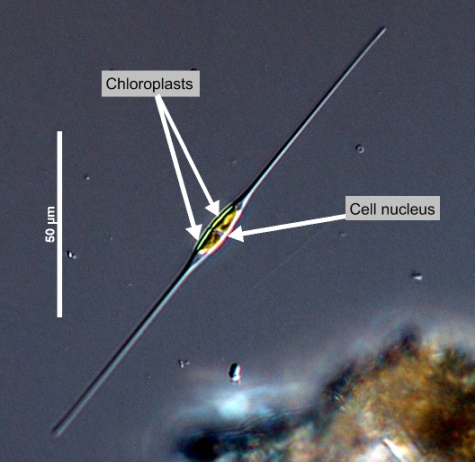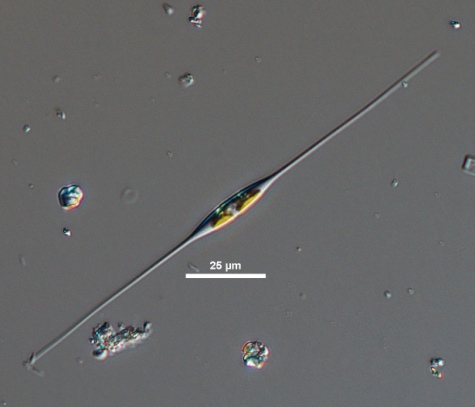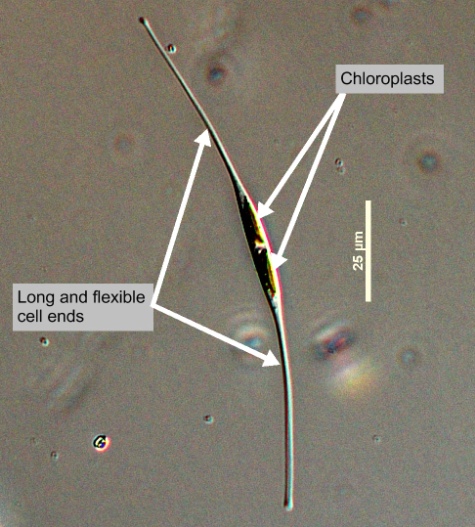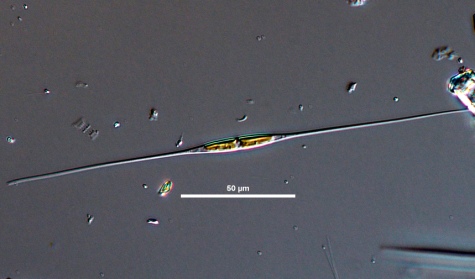



|
Synonym(s)
Heterotypic
A difference in type. In naming species, a heterotypic synonym is one that comes into being when a taxon becomes part of a different taxon. Compare to homotypic.
(heterotypic)Nitzschia closterium (Ehrenberg) W. Smith 1853 (heterotypic)
Ceratoneis closterium Ehrenberg 1839 Close
Homotypic
Expressing the same fundamental type or structure; may or may not be symmetrical (e.g., the two valves of a diatom, where they are the same shape and appearance, but one is bigger than the other). In naming species, a homotypic synonym is one that comes into being when a taxon gets a new name (without being added to an already existing taxon).
(homotypic CloseBasionym
The original name for an organism. In botany, the original published nomenclature from which a new binomial nomenclature is derived for a particular group of organisms (Tindall 1999).
basionym)(Guiry and Guiry 2011)
Classification
(Guiry and Guiry 2011)
Lifestyle
Description
Sigmoid
S-shaped.
sigmoid. The CloseNucleus
(plural: nuclei) In eukaryotic cells, a membrane-bound organelle that contains the cell's genetic information; the nucleus controls the activities of the cell by controlling gene expression.
nucleus and two chloroplasts are in the central region of the cell (Cupp 1943). Cells are yellow-brown in colour (Guiry 2011).Fusiform
Torpedo-shaped. Shaped like a small boat when viewed from above.
fusiform part not twisted, in the rostra not or only slightly twisted about the CloseApical
(axis, spine) The region of the apex or point. Refers to the most anterior point or region of the cell (HPP 2003).
apical axis. CloseValve
In diatoms, the structurally distinct halves of the cell wall (Becker 1996).
Valve face weakly CloseSiliceous
Describing the character (i.e., white, shimmery) or chemical presence silicon dioxide (SiO2) as a component of phytoplankton cell covering.
silicified, almost imperforate, transversed by more or less transapical silicified thickenings. CloseRaphe
"In some pennate diatoms, one or two longitudinal slits along the [long] axis or around the valve margins" (Horner 2002). Secretion of mucilage allows a pennate diatom to attach itself to or glide on a substrate (Regents of the University of California 2006).
Raphe transversed by a series of fibulae, joined directly to the valve face. One of the edges of the valve bordering the fissure minutely serrate. Fissure interrupted at the centre" (Reimann and Lewin 1964, cited in Hasle and Syvertsen 1997).Measurements
Centre Length: 6 - 50 μm
Width Close
Transapical axis
In diatoms, the longitudinal axis of the valve.
(transapical axis): 2.5 - 8 μmHeight Close
Pervalvar axis
The axis through the centre point of the two valves of a frustule. This axis is perpendicular to the valve face.
(pervalvar axis): 2.5 - 8 μmFibulae: 10 - 12 in 10 μm
Close
Striae
(referring to pores in diatoms) In diatoms, a striation or row of pores on the valve face. "In centric diatoms, striae may be radial, running from the centre of the valve to the margin ... In pennate diatoms, striae may be parallel to the median line of the valve or raphe" (Horner 2002).
Interstriae: 70 - 100 in 10 μm (observed in CloseTEM
(transmission electron microscope) A high-resolution microscope that works by passing a beam of electrons through a very thin specimen (CMRA 1995).
TEM)(Cupp 1943, Hasle 1964, Hasle and Syvertsen 1997 and Kraberg et al. 2010)
Similar species
Harmful effects
Habitat
Distribution
Cosmopolitan (Horner 2002).
Present throughout the year, but moderately more abundant in spring and summer in Northern European seas (Kraberg et al. 2010).
Present throughout the year in small numbers, being more abundant during late spring, summer, and early fall.
Growth conditions
Lux
(abbreviated 'lx') Units for measuring light intensity in a given surface area.
lux and above, and salinity of 20 - 40 (Ohgai et al. 1986). Upper temperature limit of ∼33 °C (Harford et al. 2011).Environmental Ranges
Temperature range (°C): -2.058 - 29.468
Nitrate (μmol L-1): 0.053 - 34.037
Salinity (PSU): 17.940 - 37.775
Oxygen (mL L-1): 4.139 - 9.116
Phosphate (μmol L-1): 0.046 - 2.358
Close
Silicic acid
A general term to describe chemical compounds containing silicon, oxygen and hydrogen with a general formula of [SiOx(OH)4-2x]n. Diatoms polymerize silicic acid into biogenic silica to form their frustules (Azam and Chisholm 1976).
Silicate (μmol L-1): 0.687 - 92.735(OBIS 2011, cited in EOL 2011)
Bloom characteristics
References
Alcoverro, T., Conte, E. and Mazzella, L. 2005. Production of mucilage by the Adriatic epipelic diatom Cylindrotheca closterium (Bacillariophyceae) under nutrient limitation. Journal of Phycology. 36(6): 1087-1095.
Cupp, E. E. 1943. Marine Plankton Diatoms of the West Coast of North America. University of California Press. Berkeley, California. 238.
Encyclopedia of Life (EOL). 2011. Cylindrotheca closterium. http://eol.org/pages/915395/overview. Accessed 02 Nov 2011.
Guiry, M. D. 2011. Cylindrotheca closterium (Ehrenberg) Reimann and Lewin, 1964. http://www.marinespecies.org/aphia.php?p=taxdetails&id=149004. Accessed 02 Nov 2011.
Guiry, M. D. and Guiry, G. M. 2011. Cylindrotheca closterium (Ehrenberg) Reiman and J. C. Lewin. http://www.algaebase.org/search/species/detail/?species_id=33309. Accessed 02 Nov 2011.
Harford, A. J., Hogan, A. C., Tsang, J. J., Parry, D. L., Negri, A. P., Adams, M. S., Stauber, J. L. and van Dam, R. A. 2011. Effects of alumina refinery wastewater and signature metal constituents at the upper thermal tolerance of: 1. The tropical diatom Nitzschia closterium. Marine Pollution Bulletin. 62(3): 466-473.
Hasle, G. R. 1964. Nitzschia and Fragilariopsis species studied in the light and electron microscopes. I. Some marine species of the groups Nitzschiella and Lanceolatae. Skrifter utgitt av Det Norske Videnskaps-Akademi I Oslo. I. Matematisk-Naturvidenskapelig Klasse. Ny Serie. 16: 1-48.
Hasle, G. R. and Syvertsen, E. E. 1997. Marine diatoms. In: Tomas, C. R. (ed.) Identifying marine Phytoplankton. Academic Press, Inc., San Diego. 5-385.
Hiromi, J., Imanishi, D. and Kadota, S. 1995. Effect of Cylindrotheca closterium (Bacillariophyceae) on the growth of red-tide raphidophycean flagellate Heterosigma akashiwo. Bulletin of the College of Agriculture and Veterinary Medicine, Nihon University. 52: 122-125.
Horner, R. A. 2002. A Taxonomic Guide To Some Common Phytoplankton. Biopress Limited, Dorset Press, Dorchester, UK. 200.
Kraberg, A., Baumann, M. and Durselen, C. D. 2010. Coastal Phytoplankton: Photo Guide for Northern European Seas. Verlag Dr. Friedrich Pfeil, Munchen, Germany. 204.
Najdek, M., Blažina, M., Djakovac, T. and Kraus, R. 2005. The role of the diatom Cylindrotheca closterium in a mucilage event in the northern Adriatic Sea: coupling with high salinity water intrusions. Journal of Plankton Research. 27(9): 851-862.
Ocean Biogeographic Information System (OBIS). 2011. Cylindrotheca closterium. http://www.iobis.org/mapper/?taxon_id=682250. Accessed 02 Nov 2011.
Ohgai, M., Iwano, H. and Hoshijima, M. 1986. The effect of the environmental factors on the growth of diatom Cylindrotheca closterium (Ehrenberg) Reimann et Lewin. Nippon Suisan Gakkaishi. 52(9): 1635-1640.
Reimann, B. E. F. and Lewin, J. C. 1964. The diatom genus Cylindrotheca Rabenhorst. Journal of the Royal Microscopical Society. 83: 283-296.
Staats, N., Stal, L. J. and Mur, L. R. 2000. Exopolysaccharide production by the epipelic diatom Cylindrotheca closterium: effects of nutrient conditions. Journal of Experimental Marine Biology and Ecology. 249(1): 13-27.
Smith, D. J. and Underwood, G. J. C. 1998. Exopolymer production by intertidal epipelic diatoms. Limnology and Oceanography. 43(7): 1578-1591.
